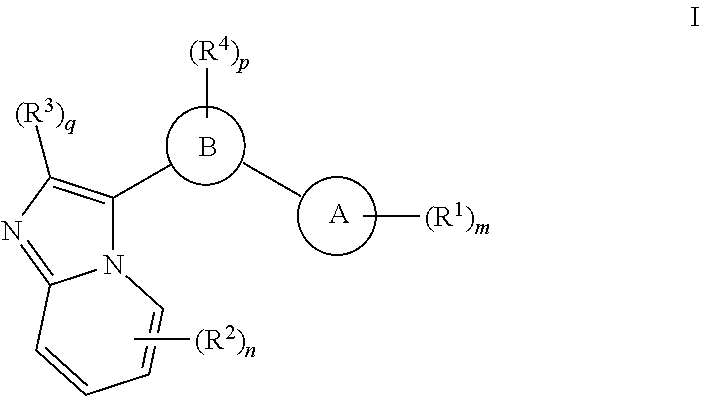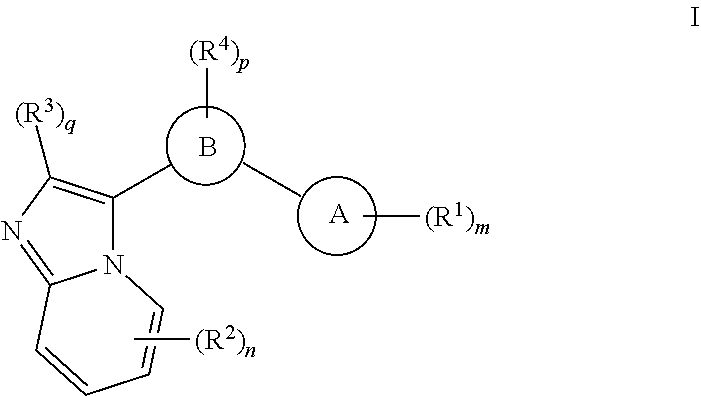Gcn2 inhibitors and uses thereof
a technology of gcn2 and inhibitors, applied in the field of gcn2 inhibitors, can solve the problems of reducing the translation of most and reducing the global utilization of amino acids
- Summary
- Abstract
- Description
- Claims
- Application Information
AI Technical Summary
Benefits of technology
Problems solved by technology
Method used
Image
Examples
example 1
(S-Methylsulfonimidoyl)methyl)piperidin-1-yl)pyrimidin-2-yl)-6-(trifluoromethyl)imidazo[1,2-a]pyridine, I-4
[0497]
[0498]3-(4-Chloropyrimidin-2-yl)-6-(trifluoromethyl)imidazo[1,2-a]pyridine (13.2 mg, 0.05 mmol), 3-((S-methylsulfonimidoyl)methyl)piperidine (8 mg, 0.045 mmol), diisopropylethylamine (8 μL, 0.045 mmol) in DMF were heated at 80° C. After 20 mins the reaction was cooled to room temperature and the mixture was filtered and purified by reverse phase chromatography (C18; MeCN / water / 0.05% TFA as eluent) to afford the trifluoroacetic acid salt of 3-(4-(3-((S-methylsulfonimidoyl)methyl)piperidin-1-yl)pyrimidin-2-yl)-6-(trifluoromethyl)imidazo[1,2-a]pyridine (12.7 mg, 40%).
[0499]The following compounds were prepared using a methodology similar to the one described in Example 1:[0500]8-Methylsulfonyl-1-[2-[6-(trifluoromethyl)imidazo[1,2-a]pyridin-3-yl]pyrimidin-4-yl]-1,8-diazaspiro[4.5]decane, I-7[0501]N-[[-4,4-Difluoro-5-methyl-1-[2-[6-(trifluoromethyl)imidazo[1,2-a]pyridin-3-yl]p...
example 2
l-4-yl-4-[2-[6-(trifluoromethyl)imidazo[1,2-a]pyridin-3-yl]pyrimidin-4-yl]morpholine and 1H-pyrazol-4-yl-4-[2-[6-(trifluoromethyl)imidazo[1,2-a]pyridin-3-yl]pyrimidin-4-yl]morpholine, I-2 and I-3
[0522]
[0523]The racemic mixture of 2-(1H-pyrazol-4-yl)-4-[2-[6-(trifluoromethyl)imidazo[1,2-a]pyridin-3-yl]pyrimidin-4-yl]morpholine (prepared using a methodology similar to the one described in Example 107) was separated by chiral supercritical fluid chromatography (conditions: OD-H, 45% MeOH, 20 mM NH3, 290 nm). The first species to be eluted was compound I-2 (99.3% ee); ESV-MS m / z 416.8 (M+H). The second specied to be eluted was compound I-3 (98.2% ee); ESV-MS m / z 416.4 (M+H).
[0524]The following compounds were prepared using a similar methodology to the one described in Example 2:[0525]7-(2-(6-(Trifluoromethyl)imidazo[1,2-a]pyridin-3-yl)pyrimidin-4-yl)hexahydroimidazo[1,5-a]pyrazin-3(2H)-one I-5[0526]7-(2-(6-(trifluoromethyl)imidazo[1,2-a]pyridin-3-yl)pyrimidin-4-yl)hexahydroimidazo[1,5-a...
example 3
4-[2-[6-(Difluoromethyl)imidazo[1,2-a]pyridin-3-yl]pyrimidin-4-yl]morpholin-2-yl]methyl]methanesulfonamide, I-13
[0534]
[0535]DBU (79.8 μL, 0.534 mmol) and PyBroP (124.5 mg, 0.267 mmol) were added to a solution of 2-[6-(difluoromethyl)imidazo[1,2-a]pyridin-3-yl]pyrimidin-4-ol (35 mg, 0.134 mmol) in MeCN (700 μL). After 5 min N-[[(2S)-morpholin-2-yl]methyl]methanesulfonamide (31.1 mg, 0.160 mmol) was added and the mixture heated at 40° C. After 2 hours the reaction was cooled to room temperature and the mixture was filtered and purified by reverse phase chromatography (C18; MeCN / water / 0.05% TFA as eluent) to afford the trifluoroacetic acid salt of N-[[(2S)-4-[2-[6-(difluoromethyl)imidazo[1,2-a]pyridin-3-yl]pyrimidin-4-yl]morpholin-2-yl]methyl]methanesulfonamide (28.2 mg, 45%).
[0536]The following compounds were prepared using a methodology similar to the one described in Example 3:[0537]N-[[(2S)-4-[2-[6-(Trifluoromethyl)imidazo[1,2-a]pyridin-3-yl]pyrimidin-4-yl]morpholin-2-yl]methyl]met...
PUM
 Login to View More
Login to View More Abstract
Description
Claims
Application Information
 Login to View More
Login to View More - R&D
- Intellectual Property
- Life Sciences
- Materials
- Tech Scout
- Unparalleled Data Quality
- Higher Quality Content
- 60% Fewer Hallucinations
Browse by: Latest US Patents, China's latest patents, Technical Efficacy Thesaurus, Application Domain, Technology Topic, Popular Technical Reports.
© 2025 PatSnap. All rights reserved.Legal|Privacy policy|Modern Slavery Act Transparency Statement|Sitemap|About US| Contact US: help@patsnap.com



